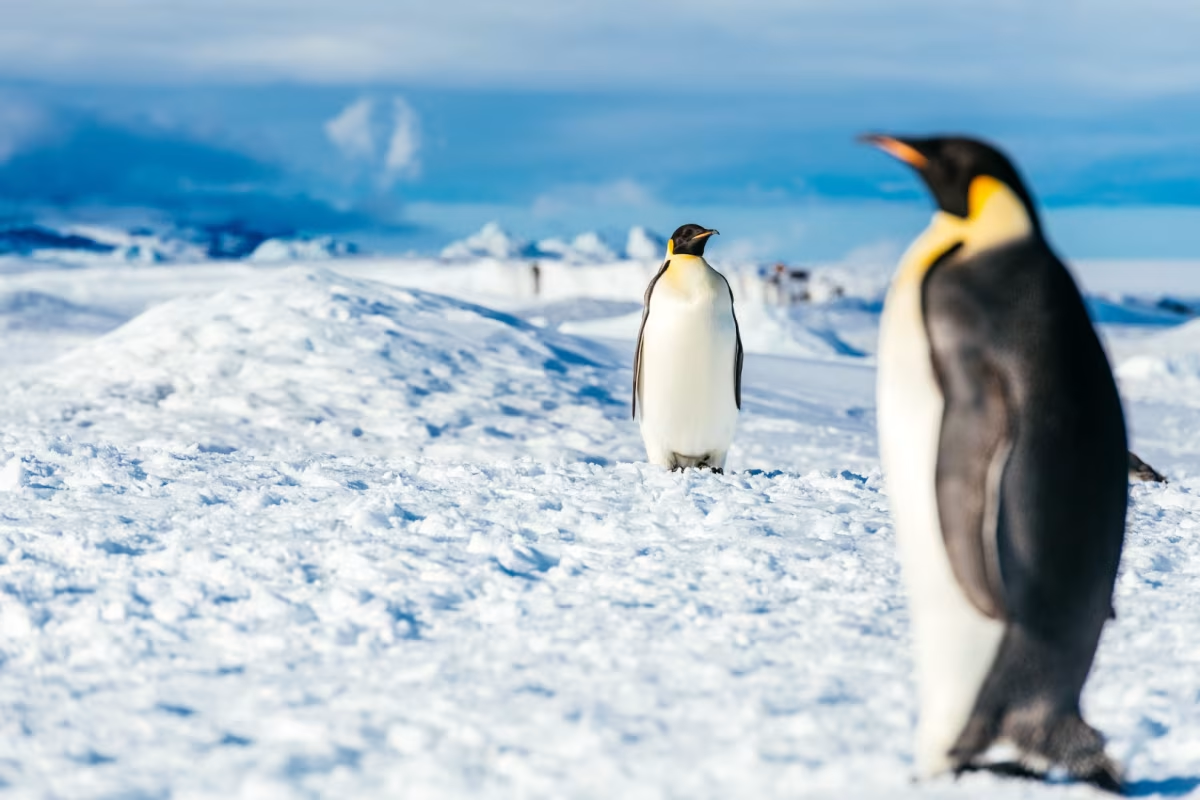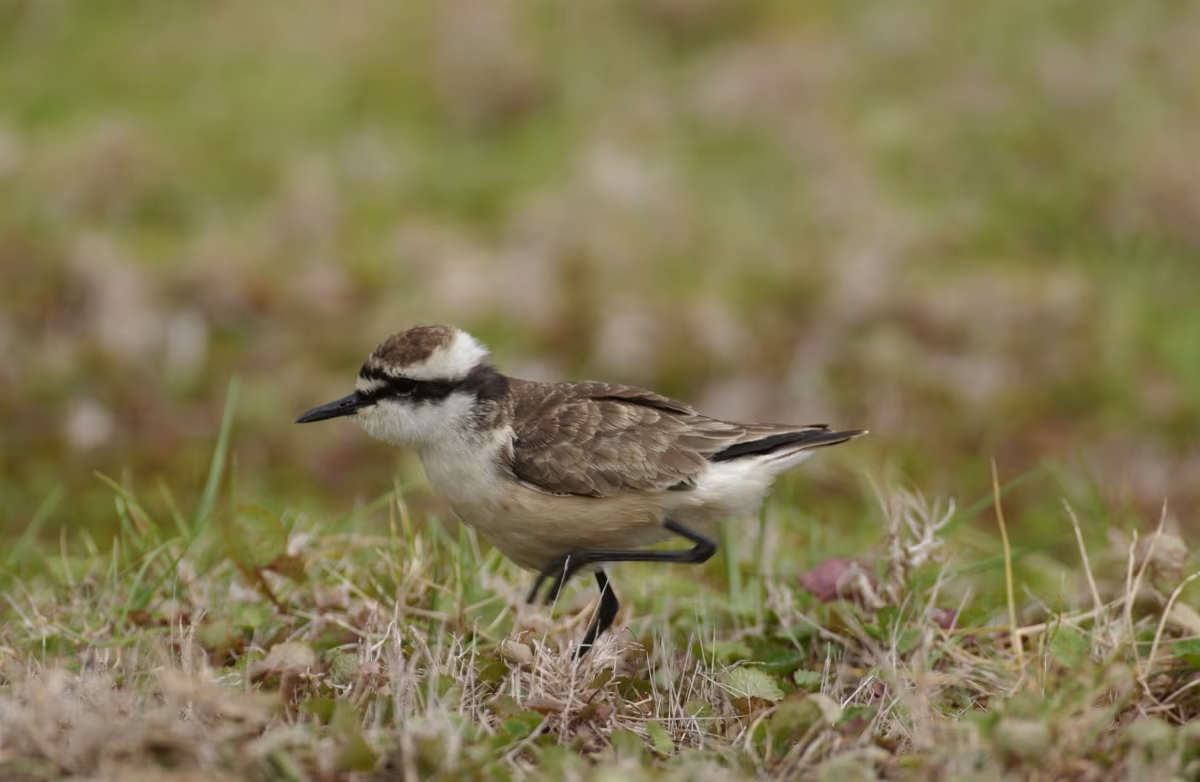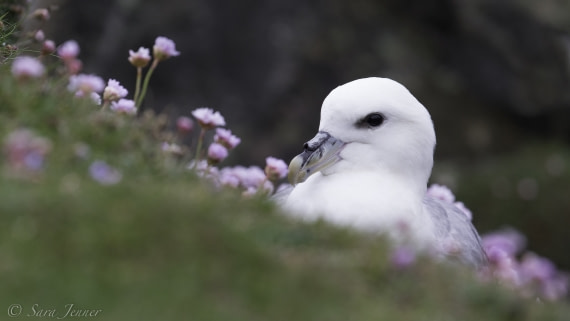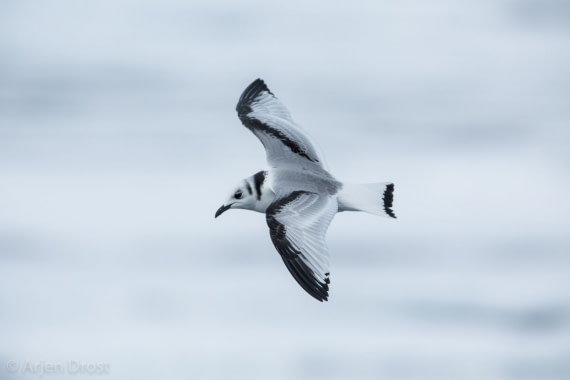Bird Watching
Plenty of our cruises offer the chance to take in a wide variety of birds. Already an accomplished ornithologist? Then we’ll take you where you want to go – off to see feathered friends you can’t reach any other way, as well as the scores of migratory species you may be more familiar with.
As for you budding bird-watchers, it will be our great pleasure to help you take your first bird-watching footsteps. Our trained staff consists often of ornithologists or keen birders and they are there to help you and point out the different species. On-board lectures will help you to gain knowledge of the birdlife. We’ve collected the following bird watching tips to help get you started.

Dress for Success
Your bird watching holiday is going to be a largely sedentary activity, so make sure you dress warm enough to combat the cold of the Polar Regions. Having to do jumping jacks to warm yourself tends to scare birds away (except for certain species of penguins who will find you fascinating). Dress in layers so you can regulate your temperature. At the same time, you’re also likely to be exposed to a lot of sun. So pack both sunglasses and sunscreen, and maybe a hat with a wide enough brim to protect your ears and neck if your cold-weather clothing isn’t already doing the job.
Binoculars for bird watching
Experts are all going to have their own opinions when it comes to equipment. If you stick with your bird watching you’ll get the chance to try out different types of gear in order to finally settle on which pieces best suit you.

There are two big factors to consider in the quality of image in binoculars – the magnification (how close the bird will appear – the higher the number the closer they’ll appear) and the quality of the image. It’s a bit of a balancing act between the two at the more affordable end of binoculars. However, generally speaking, the extra magnification isn’t necessarily worth the loss of quality of the image (the grinding of the higher magnification lenses isn’t particularly great at lower price levels).
As for pocket binoculars, they’re usually not that great a quality optics-wise. If you’re worried about how much weight you’ll be carrying you can get standard-sized binoculars (around 7 X 32mm or 8X32) that aren’t all that much bigger than pocket binos, but give a much better view.

Identification of birds
So now that you can see the birds you’re probably going to want to know what they are. The Sibley Guide is generally considered the king of guidebooks. The National Geographic’s Field Guides are also worth investigating. Know the habitats. If you know that a certain kind of bird nests, for example, within rocky cliff crevices then you’ll have a much easier time making a spotting. Also, watch the bird for a while. Don’t be in a rush to flip through your guidebook’s pages in order to nail that identification. After all, the goal of bird watching is to enjoy the bird itself. Besides, the more you watch the bird, the more points you’ll pick up that you can use for picking it out in your guide.
Here are the general steps you take for identification:
- Song – Songs and calls are a great way to identify a particular species of bird. Watch the bills in particular to make sure the song you’re hearing is coming from the bird you’re actually watching.
- Size and Shape – How big is the bird? Set some general item – like a football – as your mental comparison tool, and then compare all birds to that. Or become really familiar with one kind of bird and then measure all other birds against it. Also, what is the bird’s general configuration? Does it generally resemble a gull, a duck, or something smaller like a robin?
- Faces – Now it’s time to zoom in and get more specific. Are there any distinctive patches of colour around the eyes? Does it have any sort of display feathering off the top of its head? Does it have a coloured cap or a band of colour around the nape of the neck? How about the bill – what colour is it? Is it blunt or long? Straight or curved?
- Wings and Tails – Are the wings short and stubby (like penguins) or are they built to soar with long wide wings that don’t flap very often? Do the wings have the same colour as the back and underbelly? Do they have their own patches of colour? How about the tail – short or long? Are there streamers (extra-long middle tail feathers)?
- Feet – Webbed? Talons? How far forward or back on the body are they located? Short or long? Are there backward-facing toes?
- Flight and Movement – In flight, do the wings beat rapidly or does it soar for long periods of time? Does it have an easy time taking off from land or does it prefer to get in the water first so it has a long “runway” for take-off? If it’s a penguin does it hop or waddle? Does it like to slide along the ice on its belly?
- Eating Habits – What does the bird eat? How does it hunt or feed? Does it capture its own food or does it harass other birds to steal theirs?
- Area – Many of the birds you’ll see on our cruises are pelagic, meaning that they live most of their lives at sea. When you spot them on land chances are that they are in their mating season. So what kind of area are they nesting in? Do they build actual nests (if they do, what materials are they using?) or do they just use scrapes in the ground? Are both parents present or is one off hunting?

Breeding Birds of Antarctica
The variety of birds available for bird watching depend on where in Antarctica you are and at what time of year. While we can’t promise you’ll see them all, here are a couple of lists naming the birds where Oceanwide Expeditions operate:
- Adelie Penguin
- Antarctic Fulmar
- Antarctic Petrel
- Antarctic Shag
- Antarctic Tern
- Black-bellied Storm Petrel
- Cape Petrel
- Chinstrap Penguin
- Emperor Penguin
- Gentoo Penguin
- Kelp Gull
- Macaroni Penguin
- Pale-faced Sheatbill
- Snow Petrel
- South Polar Skua
- Southern Giant Petrel
- Sub-Antarctic (Brown) Skua
- Wilson’s Storm Petrel

Birds of South Georgia
- Antarctic Prion
- Antarctic Tern
- Black-bellied Storm Petrel
- Black-browed Albatross
- Blue Petrel
- Chinstrap Penguin
- Common Diving Petrel
- Fairy Prion
- Gentoo Penguin
- Grey-backed Storm Petrel
- Grey-headed Albatross
- Kelp Gull
- King Penguin
- Light Mantled Albatross
- Macaroni Penguin
- Pale-faced Sheatbill
- Snow Petrel
- South Georgia Diving Petrel
- South Georgia Pintail
- South Georgia Pipit
- South Georgia Shag
- Sub-Antarctic (Brown) Skua
- Wandering Albatross
- White-chinned Petrel
- Wilson’s Storm-Petrel

Picture by Meike Sjoer
Birds of the Falkland Islands
- Barn Owl
- Black-browed Albatross
- Black-chinned siskin
- Black-crowned Night Heron
- Blackish Cinclodes (Tussack Bird)
- Blackish Oystercatcher
- Black-necked Swan
- Black-throated Finch/Canary-winged Finch
- Brown-hooded Gull
- Chilean Swallow
- Chiloe Wigion
- Cinnamon Teal
- Cobb's Wren
- Common Diving Petrel
- Coscoroba Swan
- Crested Caracara
- Crested Duck
- Dark-faced ground tyrant
- Dolphin Gull
- Fairy Prion
- Falkland Flightless Steamer Duck
- Falkland Grass Wren
- Falkland Pipit
- Falkland Thrush
- Flying Steamer Duck
- Great Shearwater
- Grey-backed Storm Petrel
- House Sparrow
- Imperial (Blue Eyed) Shag
- Kelp Goose
- Kelp Gull
- King Penguin
- Long-tailed Meadow Lark
- Macaroni Penguin
- Magellanic Oystercatcher
- Magellanic Snipe
- Peregrine Falcon
- Red-backed Hawk/Variable Hawk
- Rock Shag
- Rockhopper Penguin
- Ruddy-headed Goose
- Rufous-chested Dotterel
- Short-eared Owl
- Silver Teal
- Silvery Grebe
- Slender-billed Prion
- Sooty Shearwater
- South American Tern
- Southern Giant Petrel
- Specled Teal
- Striated Caracara
- Sub-Antarctic (Brown) Skua
- Turkey Vulture
- Two-banded Plover
- Upland Goose
- White-chinned Petrel
- White-tufted Grebe
- Wilson’s Storm-Petrel
- Yellow-billed pintail

Birds Tristan da Cunha group of Islands
- Antarctic Prion
- Antarctic Tern
- Arctic Tern
- Atlantic Petrel
- Barn Swallow
- Black-bellied Storm Petrel
- Black-browed Albatross
- Broad-billed Prion
- Brown Noddy
- Brown or Southern Skua
- Cape Petrel
- Cattle Egret
- Cocoi Heron
- Common Diving Petrel
- Common Greenshank
- Common Nighthawk
- Common Ringed Plover
- Cory's Shearwater
- Eastern Kingbird
- Franklin's Gull
- Gough Island Finch
- Great Egret
- Great Shearwater
- Great-winged Petrel
- Grey Petrel
- Grey Phalarope/Red Phalarope
- Grey-backed Storm Petrel
- Grey-headed Albatross
- Inaccessible Rail
- Kelp Gull
- Kerguelen Petrel
- Leach's Storm Petrel
- Light-mantled Albatross
- Little Blue Heron
- Little Shearwater
- Long-tailed Jaeger
- Macaroni Penguin
- Nightingale Island Finch
- Northern Giant Petrel
- Paint-billed Crake
- Parasitic Jaeger/Arctic Skua
- Pectoral Sandpiper
- Purple Gallinule
- Red-gartered Coot
- Rockhopper Penguin
- Royal Albatross
- Ruddy Turnstone
- Rufous-chested Dotterel
- Sanderling
- Sharp-tailed Sandpiper
- Shy Albatross
- Slender-billed Prion
- Snowy Egret
- Snowy Sheathbill
- Soft-plumaged Petrel
- Solitary Sandpiper
- Sooty Albatross
- Sooty Shearwater
- Southern Fulmar
- Southern Giant Petrel
- Speckled Teal
- Spotted Sandpiper
- Striated Heron
- Tristan da Cunha Moorhen
- Tristan da Cunha Thrush
- Upland Sandpiper
- Wandering Albatross
- Whimbrel
- White-bellied Storm Petrel
- White-chinned Petrel
- White-faced Storm Petrel
- White-rumped Sandpiper
- Wilkins's Finch
- Willow Warbler
- Wilson's Storm Petrel
- Yellow-nosed Albatross

Ascension Island Birds
- Allen's Gallinule
- Antarctic Tern
- Ascension Frigatebird
- Band-rumped Storm Petrel
- Black Noddy
- Brown Booby
- Brown Noddy
- Common Myna
- Common Swift
- Common Waxbill
- Lesser Noddy
- Little Shearwater
- Masked Booby
- Northern House Martin
- Parasitic Jaeger/Arctic Skua
- Purple Gallinule
- Red-billed Tropicbird
- Red-footed Booby
- Red-necked Francolin
- Ruddy Turnstone
- Sooty Tern
- White Tern
- White-tailed Tropicbird
- Yellow Canary

Birds of Greenland
- Arctic Redpoll
- Arctic Skua
- Arctic Tern
- Barn Swallow
- Barnacle Goose
- Black Guillemot
- Brent Goose
- Brunnich’s Guillemot
- Common Eider
- Common Guillemot
- Common Gull
- Common Scoter
- Common Snipe
- Dunlin
- Eurasian Oystercatcher
- European Shag
- European Storm Petrel
- Glaucous Gull
- Golden Plover
- Great black-backed Gull
- Great Cormorant
- Great Northern Diver
- Great Skua
- Grey Phalarope
- Greylag Goose
- Gyrfalcon
- Harlequin Duck
- Herring Gull
- Ivory Gull
- King eider
- Kittiwake
- Lesser black-backed Gull
- Little Auk
- Long-tailed Duck
- Long-tailed Skua
- Manx Shearwater
- Meadow Pipit
- Merlin
- Northern Fulmar
- Peregrine
- Pink-footed Goose
- Pomarine Skua
- Puffin
- Purple Sandpiper
- Raven
- Red Knot
- Red-breasted Merganser
- Red-necked Phalarope
- Redpoll
- Red-throated diver
- Redwing
- Ringed Plover
- Rock Pipit
- Rock Ptarmigan
- Ross’ Gull
- Ruddy Turnstone
- Sabine’s Gull
- Sanderling
- Skylark
- Snow Bunting
- Snowy Owl
- Starling
- Wheatear
- Whimbrel
- White Wagtail
- White-fronted Goose
- White-tailed Eagle
- Whooper Swan
- Wren

Birds of Svalbard and Franz Joseph Land
- Arctic Skua
- Arctic Tern
- Barn Swallow
- Barnacle Goose
- Bean Goose
- Black Guillemot
- Black Scooter
- Blackbird
- Black-headed Gull
- Brambling
- Brent Goose
- Brunnich’s Guillemot
- Common Eider
- Common Goldeneye
- Common Guillemot
- Common Redshank
- Common/Mew Gull
- Dunlin
- Eurasian Oystercatcher
- Eurasian Teal
- Eurasian Wigeon
- European Golden Plover
- Fieldfare
- Glaucous Gull
- Great black-backed Gull
- Great Northern Diver
- Great Skua
- Grey Phalarope
- Greylag Goose
- Gyrfalcon
- Herring Gull
- Iceland gull
- Ivory Gull
- King Eider
- Kittiwake
- Lapland longspur
- Lesser black-backed Gull
- Little Auk
- Long-tailed Duck
- Long-tailed Skua
- Mallard
- Meadow Pipit
- Northern Fulmar
- Northern Gannet
- Northern Pintail
- Pectoral Sandpiper
- Pink-footed Goose
- Pomarine Skua
- Puffin
- Purple Sandpiper
- Red Knot
- Red-necked Phalarope
- Redpoll
- Red-throated diver
- Redwing
- Ringed Plover
- Rock Ptarmigan
- Ross’ Gull
- Ruddy Turnstone
- Sabine’s Gull
- Sanderling
- Snow Bunting
- Snow Goose
- Steller's Eider
- Tufted Duck
- Wheatear
- Whimbrel
- White Wagtail
- White-fronted Goose
- Whopper Swan
Bird photography tips
Except for some species of curious penguins you’re going to need a long lens for your camera. You’re also going to want a camera that has a fast focus system (if you’re not handling the focus manually). As you get more professional you might want to concern yourself with additional considerations like shutter speed and the frames per second speed – but for beginners the lens length and the focus are good first steps.
If you don’t want to break the bank you can try a zoom lens in the 80-400mm range. These aren’t going to provide images as crisp as fixed-length lenses, but it allows you to resize your image without having to swap lenses out, lets you carry less equipment, and will cost less.
At these longer lens lengths stabilisation is going to become an issue – the images can blur from the motion caused by you handholding the camera. So you might want to invest in a tripod, or at least a monopod.

In terms of shutter speed, if you’re just snapping pictures of the birds on the ground or the water then you should be fine with regular speeds. However if you intend to try to get some shots of the birds in flight then you’re going to want to ramp your camera’s shutter speeds up. Try speeds anywhere from 1/800 to 1/1600 in order to reduce motion blur.
At the very least, the general rule of thumb is to have your shutter speed set to at least match your lens length. So if you’re using a lens at 450mm, then set your shutter speed for 1/450 as well.
RAW photographs always provides a better image than shooting .jpg frames, but you’ll have to remember to bring along lots of extra storage disks or cards, and be prepared to do some extra image post processing at home.

Some birds are fairly small and hard to judge in terms of whether or not you have them in focus. In this case try to set your focus on the eye closest to you. This way, even if other parts of the bird like the tail are slightly blurred then the most captivating part – the face – will still be clear.
Try to have the sun at your back. If the light is coming past the bird into your lens chances are it will wash the bird out.
Above all else, practice! Birds can be tricky little subjects to capture, so the better you know your gear before you join your cruise the better chance you’ll have at taking home some pictures you can be proud of. Head out around your neighbourhood (early morning and late afternoon are the best times) and get some experience snapping frames of the local bird life.

What Bird Watching Tours Should I Take?
Although many birds can be seen on all of our Polar voyages some voyages and destinations have more birds to offer than others. For the keen birders and bird enthusiasts special itineraries or birding groups are sometimes arranged to offer a better bird-watching experience. Enjoy birding together with fellow birders and visit remote places with rare bird-species such as South Georgia where the Wandering Albatross breeds, the Weddell Sea and Ross Sea with Emperor Penguin rookeries or Spitsbergen with the elusive Ivory Gull.
















